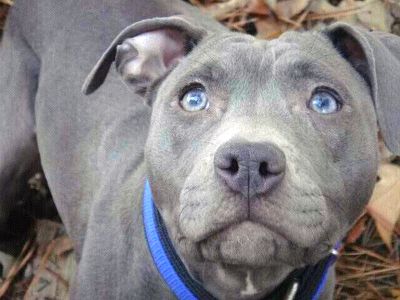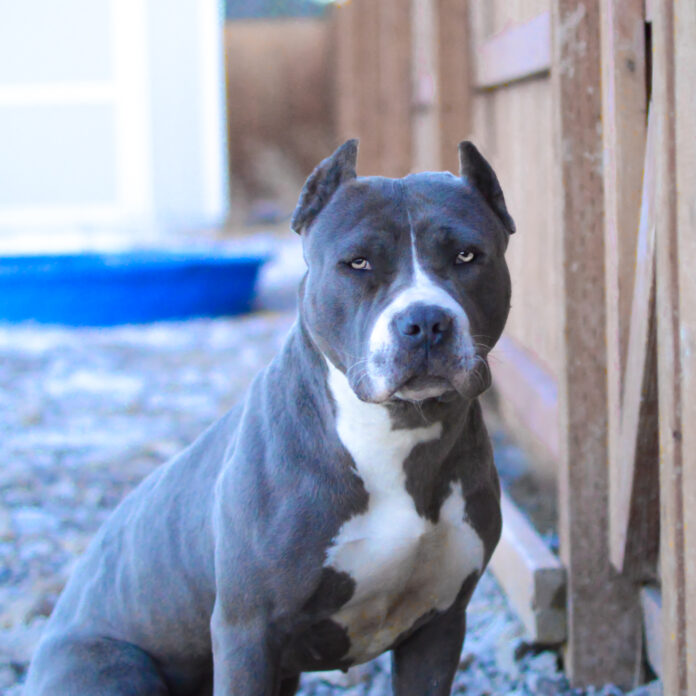Last Updated on July 2, 2021 by Fumipets
The Blue Nose Pitbull is a blue-nosed version of the American Pitbull Terrier.
In recent years, American Pitbull Terriers have earned a bad reputation due to their widespread usage in dogfighting, which has gained popularity in recent years. The majority of individuals think they are potentially harmful.
However, for hundreds of years, Pitbulls were referred to as “Nanny Dogs” because of their ease of training and their dependable temperament with children and other members of the household. Blue Nose Pitbulls are friendly and devoted to people they are familiar with, and they like playing with their owners. They make excellent family dogs.
Read on to learn more about the Blue Nose Pitbull and how to fall in love with one of these adorably loving Bull Terriers.
What is a Blue Nose Pitbull?
The Blue Nose Pitbull are either American Pitbull Terriers or American Staffordshire Terriers, or a combination of the two breeds, depending on their origin. Blue Nose Pitbulls are distinguished by the presence of certain genes that cause their coat to be blue in colour.
Because the colouration is produced by a recessive gene, they are considered to be rare dogs. Breeders must have two parents that are both “blue” to produce “blue” pups in order for this restrictive gene to be expressed.
The blue colouration of the Blue Nose Pitbull is produced by a diluted black pigment known as eumelanin; this same pigment is also responsible for the blue eyes and nose of the Pitbull breed.
American Pitbull Terriers have a long and illustrious history; they were initially developed for hunting in England as the Staffordshire Bull Terrier and brought to the United States. In the nineteenth century, they were often employed for bull and bear-baiting, and as a result, they were outlawed as a breed in the United Kingdom.
When the Staffordshire Bull Terrier first arrived in America, it was employed as a farm dog, for hunting and land protection, and for companionship, among other things.

Appearance
The Blue Nose Pitbull has a similar appearance to the American Staffordshire Terrier, except that it is blue in colour.
In appearance, Pitbulls have a wide face with a short snout. Blue Nose Pitbulls, in particular, are distinguished by their tiny blue eyes and light grey nose. Bull terriers are known for having a stocky, athletic physique with well-defined muscles.
Height and Weight
The weight of a Blue Nose Pitbull puppy may vary based on the size and genetics of the dog’s parents. Females will typically be smaller than males, as is the case with most animals.
A fully mature Blue Nose weighs between 30 and 60 pounds and stands between 18 and 21 inches tall at the shoulder.
Colours
The Blue Nose Pitbull isn’t really blue; it’s more of a light grey colour.
They usually have a complete blue coat, although it may sometimes have a brindle stripe, which gives the appearance of tiger stripes.
Occasionally, Blue Nose Pitbulls will have white markings on their faces, in the area between their eyes and down to their nose. The Blue Nose may also have white markings on their chests and feet, giving the appearance that they are wearing little shoes, which is not the case.
Coat
The Pitbull has a very short and rigid coat that is shiny in appearance.
The Blue Pit is no exception and will only need occasional brushing throughout the year since it does not shed at all. Blue Nose Pitbulls, in a similar vein, will shed a little amount twice a year, as well.

Personality and Temperament
The temperament of the Blue Nose Pitbull is similar to that of any other American Pitbull Terrier: loyal, affectionate, and playful.
Despite the fact that the Pitbull breed is often known for being aggressive toward other dogs, there are exceptions. According to the findings of this study, American Pitbulls were hostile against unknown canines but not toward humans.
Blue Nose Pitbulls, on the other hand, are very active and playful.
They are, like other energetic and clever breeds, prone to being quickly irritated by boredom and will chew everything and everything in their path. Due to the fact that bluenoses are also excellent diggers, it is a good idea to designate a specific spot in the yard where your dog may burn off some excess energy.
They rapidly establish strong connections with one another and will get connected to one another at the same time.
This is due to the Blue Nose Pitbull’s separation anxiety and tendency to become destructive out of frustration, and as a result, they do not fare well when separated from their family for extended periods of time.
Are Blue Nose Dogs Violent?
Blue Nose Pitbulls have extremely human-like emotions, and they are excellent at communicating what they are thinking and feeling to their owners. Pitbulls as a breed are not known to be particularly aggressive towards people, but they are known to be less tolerant of other animals.
If you want to keep your Blue Nose Pitbull calm and friendly, we’ve put up a list of suggestions and recommendations that you should consider following. As long as you are aware of and diligently execute the methods outlined below, your Blue Nose should not develop into a vicious canine companion.
1.Training and Obedience
A Pitbull is only as violent and disobedient as its owner allows them to be, which is something most people are unaware of. If you are not sure in your ability to teach your dog’s obedience, you should check into dog training programmes that may provide you with assistance.
2. Socialize them while they are young.
Encourage your Blue Nose Pitbull puppy to interact with other dogs from an early age by providing him with opportunities to do so. They will grow more tolerant and patient with them as a result, and they will seem less frightening as a result.
3. You are the one in charge.
Your Pitbull needs to understand that you are the one in charge. If you do not establish your dominance in front of your Blue Nose Pitbull, they will practically run circles around you.
4. Maintain a close eye on their health.
If anything is wrong with an animal, they become less patient and more anxious. Check on your Blue Nose Pitbull on a regular basis to ensure that you are not overlooking any underlying health issues. If you suspect that anything is wrong with your Blue Pit, schedule an appointment with your veterinarian as soon as possible.
5. Exercise
Walking and exercising often can help to keep your Blue Nose Pitbull calm and happy. Whenever a dog isn’t receiving what they need, it will express itself in many ways, such as chewing furniture, barking, or performing their business inside the home.

Living With The Blue Nose Pitbull
The American Pitbull Terrier, Blue Nose Pitbulls, Red Nose Pitbulls, and other Pitbull breeds are associated with a negative reputation that is difficult to overcome. After all, Pitbulls were formerly employed as fighting dogs, and this has left a lasting impression on many people.
As a responsible dog owner, it is your duty to properly teach your Blue Nose Pitbull. It’s important to be aware of their warning signals so that you can recognize when your Blue Nose is getting upset. People in your immediate vicinity will notice that you and your Blue Nose Pitbull Puppy have a strong connection, and you will feel more at peace.
Maintaining control over your Pitbull is also essential, particularly if you are walking your dog in an area where there are a lot of small children. This is done to ensure that you, your Blue Nose, and everyone else in the vicinity are comfortable.
It is possible that people who do not know you may initiate a discussion with you about how dangerous Pitbulls are and why you want one in your house. However, maintaining your composure and emphasizing that well-trained bull terriers are as safe to keep at home as any other pet can help to ease your discomfort and even soothe your wounded emotions.
Managing stigma is a necessary aspect of being a Pitbull parent, but having calm, open, and honest discussions with others who have expressed worry is the most effective approach to deal with the issue. At the end of the day, we are just human, and it is only normal to be afraid of things we do not understand.
Socializing With Other Dogs
The Blue Nose Pitbull should be socialized from a young age, ideally from birth. Blue Nose Pitbulls that have not been socialized with other dogs and their owners may be very frightening to other dogs.
Your Pitbull will grow up to be extremely antisocial and perhaps even aggressive if you do not let him to interact with other dogs, people, and other animals as much as possible. Taking your Blue Nose Pitbull on frequent walks and encouraging them to play with other dogs can make them happy and help them to interact with other people and other dogs.
It is necessary to encourage your Blue Nose to socialize on a daily basis in order to establish good social behaviour. It is something that both puppies and their owners will have to work on for many years to come in order to be successful.

Is A Pitbull A Good Family Dog?
Pitbulls were employed as “Nanny Dogs” in 19th-century Britain to protect and play with youngsters, and they still are today. If they are properly taught and socialized from a young age, they may be excellent with children.
Pitbulls are great with children, but it’s important to constantly watch your dog while it’s with a child and teach them some basic dog communication.
Because they were developed for hunting, American Pitbull Terriers are prone to pursuing prey and other small animals. As a result, they may be prone to chase tiny children as well as other young children.
They are very loving and will develop strong attachments to every member of the household. It has been shown that dogs that are prone to suffering from separation anxiety exhibit less symptoms when they are raised in big families.
Training a Blue Nose Pitbull
The Pitbull is a bright and intelligent breed, yet it can also be obstinate at times. When you’re teaching them, be patient with them.
As long as you provide them with regular and brief training activities, you will eventually have a well-trained dog.
Positive reinforcement has been shown to be the most successful form of training, and it is the most often used. Punishment may result in your dog exhibiting undesirable and harmful habits as well as developing health problems.
Reward your Blue Nose Pitbull when he or she obeys your instructions. You may reward them with a treat, praise, or more playtime.
Begin teaching your Blue Nose puppy as soon as you get them home from the breeder. Boredom and destructive behaviour in this breed are prevented by providing them with a great deal of mental activity.
After training your Blue Nose, you should engage in some light play with them to make the experience more enjoyable. This has been shown to enhance your dog’s memory while also relieving tension in certain cases. Play games like hide and seek with your children. A variety of agility activities and sports will be beneficial to them, so you may want to consider installing an obstacle course in your backyard.
Pitbulls, in particular, need early socialization, so enrol your Blue Nose in puppy courses and introduce him or her to a diverse group of people, including children and other dogs.

Taking Care of a Blue Nose Pitbull
Blue Nose Pitbulls are an active breed that need continuous care. They are not suitable for apartments and cannot survive on their own for extended periods of time.
Exercise Requirements
The Pitbull is an active and playful breed that has to be exercised on a daily basis to avoid boredom and fat.
Every day, pitbulls should get at least 90 minutes of exercise. Walking, jogging, and frequent play are all examples of this. When walking your Blue Nose, keep them on a leash and stay away from dog parks, since Pitbulls are renowned for their unpredictable behaviour among other dogs.
Because the Blue Nose Pitbull was developed for hunting, it is a highly athletic dog. Agility activities are ideal for this breed since they provide them with the necessary exercise and mental stimulation.
Shedding and Grooming
The Blue Nose Pitbull’s grooming is simple and easy. They are a low-maintenance breed.
Blue Noses have a short, tough coat that requires just occasional brushing and washing. To maintain oral hygiene, clean your dog’s teeth on a regular basis or offer them a dental stick alternative.
To prevent overgrowth and splitting, be sure to trim your Pitbull’s nails on a regular basis. To prevent infections, check their ears for wax accumulation and debris.
Finally, make frequent grooming a pleasant experience for your Pitbull by including it into their daily routine. This will help you and your Blue Nose form a strong connection.
Diet and Feeding
A balanced diet is necessary for a dog to have a healthy life.
Protein is required because it can be turned into glucose for energy. In fact, it is preferable for them to have meals that are rich in protein.
The amount of food you give your Blue Nose Pitbull is determined by their weight and age.
A smaller Pitbull should be given 1.5 cups of kibble split into two equal meals each day, whereas bigger Pitbulls should be fed 2.5 cups. They should have two meals each day: one in the morning and one in the evening.

Common Health Problems
The Blue Nose Pitbull’s colour is the result of years of inbreeding, which means the gene pool is limited. This implies they’re more prone to acquire the following health problems:
Hip-Dysplasia
An hereditary illness that causes deformity in the hip joints is one of the most frequent health issues in Pitbulls. Hip joints that develop incorrectly cause discomfort and arthritis. Unfortunately, American Pitbull Terriers are prone to it. Keep an eye out for lameness in the rear legs and/or trouble getting up from laying down in your Blue Nose Pitbull. Arthritis may be treated, and the sooner you start, the better, to prevent pain and suffering in your Blue Nose.
Skin allergies
Skin allergies are another of the most frequent health issues in American Pit Bulls and similar breeds, such as the American Staffordshire Terrier. Due to a recessive trait, Blue Nose Pit Bulls that have been bred to have a ‘blue’ coat are regrettably more prone to skin diseases. Additional than heredity, there are a variety of other factors that contribute to skin problems in Pit Bulls. Fleas and other environmental variables are frequent triggers.
Environmental Factors
Environmental factors are a frequent source of skin allergies in Blue Nose Pitbulls. Your Blue Nose may be sensitive to grass, pollen, or another allergen that comes into touch with their skin. It may also be the shampoo you’re using, in which case you could try a different shampoo or give your Pit Bull Benadryl to assist with the hives and itching.
Hypothyroidism
Inflammation or shrinking of the thyroid gland causes this health issue in Blue Nose Pitbulls. Hypothyroidism is more prevalent in medium to big breeds, such as American Pitbull Terriers, and develops in the middle of their lives.
Keep an eye out for the most frequent symptoms of poor thyroid function in your Blue Nose, such as hair loss or thinning, a dull hair coat, and excessive shedding or scaling. It also leads to abnormal weight gain and obesity, decreased exercise, and a decreased capacity to withstand cold temperatures. Ear infections are common in hypothyroid Pitt Bulls, as are ear discomfort, redness, and odour. Your Blue Nose may also develop skin infections, which may be painful and cause body sores.
Juvenile Cataracts
The opacity of the lens in the eye of your Blue Nose Pitbull dog or puppy is another frequent health issue. The lens is located immediately behind the pupil and is usually translucent. A cataract prevents enough light from reaching the retina, obstructing your Blue Nose’s regular vision. Although the majority of instances manifest after the age of five, your Pitbull may manifest at any age. Some Blue Nose Pitbull pups are born with cataracts, while others acquire them later in life. The symptoms may range from a little white spot to a completely opaque coating that covers the whole lens. Check your Blue Nose’s eyes on a daily basis since if the lens gets totally covered, it may cause blindness.
Life Expectancy of Blue Nose Pitbulls
Blue Nose bull terriers have a lifetime of 12-15 years, although exercise, nutrition, activity levels, and heredity all have a part in how quickly they age.
Conclusion
The Blue Nose Pitbull is ideally suited for an owner who isn’t scared of the undeserved reputation that Pitbulls have in general.
A Blue Nose will unconditionally adore you and establish a deep connection with you and your family. They will want to spend the whole day with you and may grow clingy.
Pitbulls need a lot of attention and physical activity. A Pitbull should have 90 minutes of exercise and play each day.
Blue Nose Pitbulls don’t shed much and don’t need brushing on a regular basis. They offer a lot of affection and flourish in large households where your Blue Nose may receive a lot of attention.


















